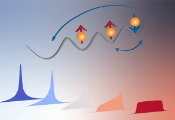Kagome Breaks the Rules at Record Breaking Temperatures
October 29, 2024 -- Using muon spin rotation at the Swiss Muon Source SμS, researchers at PSI have discovered that a quantum phenomenon known as time-reversal symmetry breaking occurs at the surface of the Kagome superconductor RbV₃Sb₅ at temperatures as high as 175 K. This sets a new record for the temperature at which time-reversal symmetry breaking is observed among Kagome systems.
Excuse me, what?
Yes, you read that right: 175 K, a.k.a. -98 degrees Celsius. In the quantum world this is actually quite hot. In the bulk of the material RbV₃Sb₅, time-reversal symmetry breaking sets in at a much lower temperature, i.e. 60 K, or -213 degrees Celsius.
OK, so it’s like Kagome can be in its creative zone while sitting in the sauna. What’s the big deal?
Time-reversal symmetry breaking (TRS-breaking) is a hallmark of unusual electronic and magnetic behaviour that can lead to exotic quantum phases: phenomena that could potentially be very useful in quantum technologies. So, finding this at a more ‘manageable’ temperature is exciting.
Wait a second, help needed. Time-reversal symmetry breaking?
Time-reversal symmetry (TRS) is the idea that the laws of physics are the same whether time runs forward or backward. In certain materials, such as this Kagome superconductor, this symmetry can be violated, meaning the system behaves differently if time were reversed.
In the Kagome material studied in this work, under certain conditions, the collective behaviour of the electrons (known as charge order) creates magnetic fields that break this symmetry. This type of charge order is associated with unusual magnetic and transport properties, so it’s of great interest.
….and Kagome? We keep tossing the word around, but what does it actually mean?
Kagome is the name of a traditional Japanese basket-weaving design, formed from a pattern of corner-sharing triangles. But condensed matter physicists discovered a while ago that if atoms are arranged in this structure, the collective behaviour of electrons gives rise to exotic and sought after quantum phenomena.
In the case of RbV₃Sb₅, one of these properties is superconductivity, which kicks in below a truly chilly 2 degrees Kelvin. Yet other quantum phenomena, which also hold promise for technological applications, appear at higher temperatures: for example, our good friend TRS-breaking.
So the crux of the matter is that they’ve discovered a super cool property at a not too chilly temperature?
That’s part of it, yes. The key here, however, is not just that TRS-breaking happens at a high temperature. It’s that it depends on the depth in the material, i.e. the distance from the surface down into the bulk. This means that the quantum phase can be tuned.
This tunability offers a pathway to control the material's electronic and magnetic properties at more accessible temperatures. An important part of using exotic quantum phenomena in real-world applications is the ability to manipulate them.
Help me place this story in the correct part of my head.
Ultimately, this story is part of the broader puzzle of unconventional superconductivity, and the search for it under more accessible conditions. The same research team, led by Zurab Guguchia, previously linked TRS-breaking to superconductivity in this material. While the most recent study did not probe superconductivity, the team believe their findings indicate that superconductivity will also be tuneable with depth; something the team are planning to investigate.
I feel like I’ve read something about this before. And not because I’m weaving baskets in my free time.
If this story sounds familiar, you’ve been paying attention. Guguchia and his team published in Nature in 2022 the big discovery of TRS-breaking charge order in a similar Kagome superconductor: a major breakthrough in the field. Since then, they have gone on to show how this phenomenon can be tuned under various conditions and established the link to unconventional superconductivity.




































